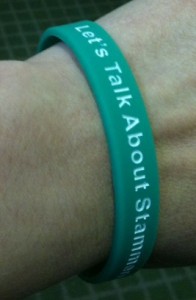 This post is something of a departure from my usual focus and normal service will be resumed next time. This post is going to be about my work-related (and higher-education related) experiences of coping with a stammer. Is “coping” the right word? I’m not entirely sure – working with, working around, working through.. something along those lines, anyway.
This post is something of a departure from my usual focus and normal service will be resumed next time. This post is going to be about my work-related (and higher-education related) experiences of coping with a stammer. Is “coping” the right word? I’m not entirely sure – working with, working around, working through.. something along those lines, anyway.
You should continue to read this (even if it’s not the kind of topic you normally come here for) because you’re a decent human being who is interested in finding out what it’s like to walk in someone else’s shoes and how you can avoid making their lives harder than they need to be. And in return, you can ask me anything you like about stammering in the comments below, or via email if you prefer. I absolutely don’t set myself up as any kind of authority or spokesperson – especially as my own stammer is atypical and relatively mild – but I have my own experiences, my own opinions, I’m open about my stammer, and willing to answer questions.
Some facts
Approximately 5% of under 5s and around 1% of adults have a stammer, and these numbers are pretty consistent across cultures, social class, and over time. Between 3.5 and 4 times as many men stammer as women. There’s a weak genetic component. There’s no cure. While psychological factors may make a stammer worse or better at any given time, research points to a neurological cause. A stammer is not a sign of low intelligence, slow wits, childhood trauma, low resilience, or mental illness, and is not the same as – or caused by – shyness, nervousness or introversion. Though it may itself cause or contribute to those things. Stuttering and Stammering are interchangeable terms.
Stammering ‘disfluency’ generally takes three forms. Repetition (“r…r….repet-repetition”), stretching (“stretttccchhhhiiinnnng”), and blocking (“……. blocking”). Repetition is probably what most people would recognise as stammering. My own stammer is about 95% blocking, 5% stretching.
“Stammer? You don’t have a stammer”
My stammer is fairly mild and a lot of people don’t notice, or if they do, think it’s just something idiosyncratic about me rather than making the connection. Some people don’t believe me when I tell them. They don’t notice because I’m pretty good at passing for fluent through various tricks and techniques and distractions. Where repetition-stammering is hard to hide, blocks can be worked around and disguised. This can lead to a form of stammering called “covert” or (better) “interiorised“. Like the swan gliding across the lake, there’s a huge amount of effort and kicking and splashing going into maintaining that illusion of effortless serenity. Everything about the way I speak is carefully crafted to hide my stammer. It’s hard to explain what that’s like, because I’ve never known anything different, but the best analogy I can come up with is a resource-hungry computer program, always running in the background, always taking up some measure of resource that could be better used for something else. For people who are not open about their stammer, being ‘caught out’ can be something they dread, and although some of that dread has dissipated for me, I still find myself working very hard to pass for fluent.
Particular Issues for Higher Education
1% of the adult population is really quite a lot, and I expect that’s a lot higher than most people think. Probably 1% of your students, 1% of your colleagues. The chances of you not knowing anyone who has a stammer is really quite small. Stammering usually counts as a disability under the Disability Discrimination Act – yet I’ve never heard it mentioned on any disability awareness training, whether in relation to supporting students or staff.
Meetings and Tutorials
Sorry to keep labouring this point, but if you have five tutorial groups with twenty students each, chances are that one of your students will have a stammer. As a module tutor, or as chair of a meeting or a conference session, there are a few things you need to be aware of, and to consider. For general information about how not to embarrass yourself when talking to someone who stammers, I’d suggest this (for work) and this (for everyday situations), but if you’re chairing meetings or tutorials, you have to consider and control the behaviour of other people too.
At one point in my working life (details removed to protect the guilty), I had to attend a semi-regular meeting. I used to dread this meeting, because it had the perfect storm of a weak chair and a number of participants who sought to dominate. People would regularly talk over each other (increasingly loudly), not listen properly, and interrupt. When I was able to get a word in edgeways, I’d manage about half a sentence before someone would take a wild guess at what contribution I was going to make and then interrupt. This was a problem for me for four reasons:
- it’s damn rude. Were other people not taught this when growing up?
- the view that had been ascribed to me or the impression I’d been permitted to give was often not what I’d intended to say. What I hoped would be a nuanced and sophisticated and useful contribution would regularly be cut off before I’d made it past the obvious
- I plan what I’m going to say quite carefully to maximise my chances of being able to say it, and I can’t recalibrate quickly to take account of interruptions or questions
- I don’t have the vocal agility to verbally fend off people when they interrupt me
Back then I wasn’t open about my stammer, and virtually never mentioned it to anyone. These days I wouldn’t stand for being treated like that, but that’s because I have more life experience, more personal and professional confidence and higher expectations of the reactions of people around me. You’ll note, though, that of the four reasons why you shouldn’t allow your meeting or tutorial to run as a Competitive Interruptathon, only two of them apply exclusively to people who stammer. So there’s not really any special pleading here – just another reason why if you’re running a tutorial or chairing a meeting you actually need to chair it. It’s your job to stop people interrupting, to watch for signs that people are trying to contribute, to allow the less vocally assertive to have the chance to contribute, and for that contribution to be listened to. Please do your job.
It’s also a potential issue at conferences. As a postgraduate student I once went to a presentation from a visiting speaker and plucked up the courage to ask a question, which was answered. But before I could follow up, the self-appointed Alpha Academic in the room (you know, the man – always a man – who always prefaces asking questions with a deep sigh) interrupted me. Not just spoke at the same time, actually deliberately interrupted and spoke right across me – effectively dismissing me and my ideas and my contribution as worthless, to ask yet another question about his hobby horse. ‘Was there anything else you wanted to…” murmured the chair, afterwards, far too little and far too late. I just shook my head and went home feeling furious and humiliated, and I can’t be sure that this incident didn’t play some role in me deciding that I didn’t want to pursue an academic career.
Another task as chair or tutor or even in everyday conversation is not to accidentally humiliate yourself or someone else through your own thoughtlessness. If you ask me an open-ended question, I can navigate around my stammer and give you a fairly fluent answer. If you ask me a closed question with only one possible answer, there’s a chance I might not be able to give it to you immediately. This is particularly common when I’m asked for my name, or for some other obvious snippet of information where I can’t cover my block by pretending to be thinking about it, making up my mind, or trying to remember. When I moved house a couple of years back, my ability to fluently state the address of potential abodes was a minor consideration in decision-making. Growing up, I used to dread maths (and to a lesser extent, sciences), where there was only one answer that could be given, and using faux-doubt to hide a slow answer wasn’t always an option.
Something that still happens to me occasionally is that someone asks me my name, and sometimes I’m unable to answer within the apparently-obligatory two seconds, and the next question is sometimes along the lines of whether I’ve forgotten my name. I’ve already said that 1% of adults have a stammer, and although I don’t have the figure to hand for spontaneous amnesia, I’m prepared to stick my neck out and guess that it’s much lower. So if it happens to you when you’re speaking to someone…. you know… play the percentages, keep your mouth shut, and be a fraction more patient.
Laughing and asking me whether I’ve forgotten my name gives me a difficult choice to make. One option is just laugh along with everyone else, use that to buy a bit of time, get an answer out somehow, try not to show how humiliated I’ve just been made to feel, and then say nothing else. The other option is that I call my interlocutor out on their behaviour, and explain that I have a stammer. But by doing that, even calmly and politely, I embarrass the person who asked the question, risk putting everyone else present on edge, and reveal personal information which may not be appropriate. In any case, most people who do this aren’t malicious, and are just reacting (however inappropriately) to cover a moment that they perceive as awkward.
I used to think this was more of a dilemma than I do now – these days I think I have an educational duty, and I’m much less prepared to take the hit for someone else’s thoughtlessness. But if you factor in power differentials it’s much harder. Did I call tutors out on this as a student? Absolutely not. Would I call out senior colleagues on it today? I’d like to think so, but I’m honestly not sure.
Other issues
Presentations can be a particular issue for people who stammer. Public speaking is something that most people worry about, but for people who stammer it can be an even greater concern. I’m fairly fortunate in that I’ve had quite a lot of practice of public speaking/teaching/coaching, and that I’m usually able to process it as performance or acting rather than me speaking. I’ve taken to telling the audience at the start of presentations that I have a slight stammer, and I’ve found that that helps me. Even if I don’t subsequently stammer during the presentation, I know that if I do, it won’t come entirely as a surprise. In fact, the very first time I mentioned it was as part of a presentation for my current role, and the positive reaction told me a lot about the culture of the place.
It’s hard to say whether it’s best to expect someone who stammers to give a presentation – either as part of a module assessment or as part of their job – or make an exception for them. Certainly it’s hard to imagine being an academic without a requirement to present, and I’d imagine that presentation skills would be important for most graduate career paths. So I tend to think that unless someone has some combination of a very high level of anxiety and/or a severe stammer, it’s probably best to encourage them to present and make sure that there’s a supportive environment. Even little things like subtly asking if they have a preference about when to present may help – generally people don’t like being first up or having a nerve-shredding wait until the end. Of course, in a group exercise it may be that someone who stammers decides to contribute to their team in other ways, but I think it would be a shame not to get some experience. But equally, getting another team member to present might well be a “reasonable adjustment” of the kind expected in the workplace by the DDA.
One final issue to mention is telephone calls. I hate using the phone, and will avoid it if I possibly can. Non-verbal communication and body language suddenly doesn’t work. If I get a block, it just comes over as a silence on the other end, and that’s quite hard to cover for. I’m usually okay once I get going, and it’s easier if someone calls me than if I call them, as they already know who I am, and what the topic of the conversation will be. So you may well find that people who stammer prefer email or face-to-face conversations than phone calls.
Finally…
I’ve gradually”come out” about my stammer over the last three years or so, and although it’s not been my experience that being open about it has made it go away or reduced it, what it has done is enable me to worry about it less. Of course, many people who stammer don’t have the option of hiding it, but what I would say is that my experience of being much more open about it has been entirely positive. The vast majority of people are more than capable of focusing on what’s being said rather than how it’s being said, and these days (especially in university environments) I think there’s more acceptance and understanding of difference and disability than in the past. Four out of five children who stammer will grow out of it, and I’d say that an even higher proportion of children who mock those who are different from them will also – largely – grow out of it. The workplace or the university campus is not the playground.
Right. That’s more than enough from me. Any comments or questions?
[Updated 27/09/19 to fix outdated links]
 he ESRC have recently added a little more detail to a previous announcement about a pending call for European-Chinese joint research projects on Green Economy and Population Change. Specifically, they’re after projects which address the following themes:
he ESRC have recently added a little more detail to a previous announcement about a pending call for European-Chinese joint research projects on Green Economy and Population Change. Specifically, they’re after projects which address the following themes:
 This post is something of a departure from my usual focus and normal service will be resumed next time. This post is going to be about my work-related (and higher-education related) experiences of coping with a stammer. Is “coping” the right word? I’m not entirely sure – working with, working around, working through.. something along those lines, anyway.
This post is something of a departure from my usual focus and normal service will be resumed next time. This post is going to be about my work-related (and higher-education related) experiences of coping with a stammer. Is “coping” the right word? I’m not entirely sure – working with, working around, working through.. something along those lines, anyway. In
In  There was an interesting snippet of information in an article in this week’s
There was an interesting snippet of information in an article in this week’s